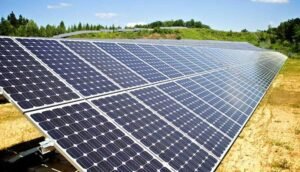India Ranks 3rd Globally with 125 GW Solar Power Capacity
|
General Studies Paper III: Government Policies & Interventions, Renewable Energy |
Why in News?
The Indian Union Minister announced that India has achieved a major milestone in renewable energy as it now ranks third globally with around 125 GW of solar power capacity. This milestone highlights the nation’s progress in clean energy growth.
Current Status of Solar Power Capacity in India
-
- National Capacity: India’s installed solar power capacity stood around 125 GW by September 2025. This makes the country the third largest solar producer globally. This includes grid-connected utility solar, rooftop solar, hybrid systems, and off-grid installations. It forms nearly 48 % of India’s non-fossil energy portfolio. In the fiscal year 2024-25, approximately 23.83 GW of solar capacity was added—this includes ~81 GW ground-mounted, ~17 GW rooftop, ~2.9 GW from hybrid solar projects, and ~4.7 GW off-grid systems.
- Growth Trend: In the first half of 2025 (January to June), India added about 14.3 GW of utility-scale solar capacity, which is ~49 % more than the same period in 2024. For the full FY 2024-25, the country added some 29.52 GW of new renewables; of that, solar dominated the addition.
- Power Mix: As of June 2025, India’s total installed power generation capacity was around 476 GW. Of this, non-fossil sources (renewables + nuclear) contributed about 235.7 GW — nearly 49 % of the total. Thermal (coal, gas) capacity remained dominant, around 240 GW.
- State-wise Contribution: States like Gujarat, Rajasthan, Maharashtra have contributed more than half of recent solar + wind capacity additions. Gujarat alone added ~6,632 MW of green capacity between April–August 2025, pushing its solar share significantly. In Tamil Nadu, as of August 2025, the installed solar capacity across ground, rooftop, and off-grid systems is ~10,983 MW.
- Notable Project: The Bhadla Solar Park in Rajasthan is India’s largest solar park, with capacity around 2,245 MW. This park underscores India’s ambition at scale. Across states, large solar parks and ultra-mega projects are being deployed.
Indian Government Initiatives for Solar Energy Growth
The Ministry of New and Renewable Energy (MNRE) has implemented various policies to streamline solar project approvals and reduce regulatory hurdles.
- PM Surya Ghar – Muft Bijli Yojana (PMSGMBY): Launched in February 2024, the PM Surya Ghar – Muft Bijli Yojana aims to install rooftop solar panels in 10 million homes across India. The scheme offers subsidies up to ₹78,000 for a 3 kW system, making solar energy accessible to low-income households. Beneficiaries can also earn by selling surplus electricity to the grid.
- PM KUSUM Scheme: The Pradhan Mantri Kisan Urja Suraksha Evam Utthaan Mahabhiyan (PM KUSUM) scheme supports farmers by providing subsidies for installing solar-powered pumps and small solar plants. The scheme aims to install 10 GW of decentralized solar capacity, including 1.4 million off-grid solar pumps and 3.5 million grid-connected agricultural pumps.
- Ultra Mega Solar Project: The government has developed large-scale solar parks to facilitate solar project development. The capacity of this initiative was enhanced from 20,000 MW to 40,000 MW, with a target completion by 2025–26.
- Rooftop Solar Subsidy Program: Under the National Portal for Rooftop Solar, the government offers subsidies for residential rooftop solar installations. Households can receive ₹30,000 per kW for up to 2 kW capacity, and ₹18,000 per kW for additional capacity up to 3 kW.
- Battery Energy Storage Systems (BESS): The government supports the adoption of Battery Energy Storage Systems to enhance grid stability and enable solar power utilization during non-sunny hours. The central government provides viability gap funding of ₹18 lakh per MWh to encourage BESS deployment.
- State-Level Initiatives: Various states have launched their own solar energy programs to complement national efforts. For instance, Maharashtra’s SMART Solar Scheme offers additional subsidies for rooftop solar installations, aims to benefit 5 lakh consumers, including Below Poverty Line (BPL) families and economically weaker sections.
Significance of Solar Energy Dominance for India
- Energy Security: India’s growing solar capacity, now around 125 GW as of October 2025, strengthens national energy security. It reduces dependence on imported fossil fuels and protects the country from global price fluctuations. The government set a target of 500 GW non-fossil fuel capacity by 2030, with solar playing a major role.
- Environmental Benefits: Solar energy helps reduce carbon emissions significantly. In 2025, India’s solar generation avoided approximately 100 million tonnes of CO₂ emissions, contributing to global climate goals. Increased solar adoption supports cleaner air, mitigates climate change, and preserves natural resources for future generations. Efforts extend beyond solar modules to emerging areas like green hydrogen, targeting 5 million tonnes of production by 2031.
- Economic Growth: The solar sector drives economic growth by creating jobs in manufacturing, installation, and maintenance. By 2023, India’s solar industry employed over 1.2 million people across various roles. It also attracts investment, strengthens domestic industries, and boosts local economies. The overall renewable energy sector is projected to create over 3 million jobs by 2030.
- Rural Electrification: Solar power has transformed rural energy access through initiatives like PM Surya Ghar and PM-KUSUM. Over 20 lakh households now receive electricity via decentralized solar solutions. This empowers communities, improves living standards, and supports rural productivity.
- Cost Competitiveness: Solar energy has become more affordable than conventional sources. By 2025, utility-scale solar power costs dropped to around ₹2.25 per kWh, making it one of the cheapest sources of electricity in India. It helps reduce electricity bills for households and businesses.
- Global Leadership: India’s solar dominance enhances its global leadership in renewable energy. As the third-largest solar producer, India plays a key role in the International Solar Alliance (ISA), guiding other countries in clean energy deployment. This strengthens international partnerships.
|
International Solar Alliance (ISA)
|
|
Also Read: India’s Solar Imports Could Reach $30 Billion Annually by 2030 |











